Repair Topics
Do It Yourself Plumbing Repair
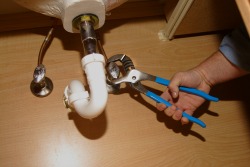 Do you have a plumbing problem? Do you want to solve it without having to spend hundreds of dollars? Calling a repairman is the obvious choice. There are other options including 'Fixing it Yourself'. This aticle on 'Do It Yourself Plumbing Repair' is designed to help you solve problems with plumbing and save a lot of money in the process.
Do you have a plumbing problem? Do you want to solve it without having to spend hundreds of dollars? Calling a repairman is the obvious choice. There are other options including 'Fixing it Yourself'. This aticle on 'Do It Yourself Plumbing Repair' is designed to help you solve problems with plumbing and save a lot of money in the process.
Below we have some 'Troubleshooting' information that should help you quickly locate your problem and find the right information. Read through the descriptions and click on the area that best describes your problem. When you arrive at the page you will find detailed information that will direct you to the righ solution to your issue. Why spend money when you don't need or want to? Consider the information below.
Troubleshooting Plumbing Problems
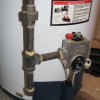 Troubleshooting Water Heaters
Troubleshooting Water Heaters
The fuel that is used to heat water in most homes is either gas or electric. With that said, some problems are common to all hot wate heaters, no matter what type of fuel they use. Other problems are specific to the type of water heater that it is.
Not sure what type of water heater you have? It is pretty easy to tell. Gas water heaters have a vent pipe, metal or plastic at the top that goes to the outside or into a chimney. The have a gas line hooked up to them near the bottom and you should be able to see a pilot light in the small access door at the bottom.
Electric water heaters do not need a vent and they have an electric power line coming into the top. There are usually two access plates on the side of the unit. Sometimes these are a different color.
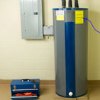 Electric Hot Water Heater Troubleshooting
Electric Hot Water Heater Troubleshooting
Electric hot water heaters use elements to heat the water, most have two. There are also thermostats that control them. If any of these parts fail, you will either have no hot water or reduced quantities available. Some simple electrical tests can help you to locate the mis-behaving part. See 'Electric Water Heater Thermostats and 'Water Heater Element Testing' for more information.
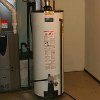 Gas Hot Water Heater Troubleshooting
Gas Hot Water Heater Troubleshooting
Natural and propane gas are popular inexpensive fuels for water heating needs. However, gas is dangerous and can explode. Gas water heaters have built in safety features that keep this from happening. The problem is that they 'Err' on the side of caution. See the articles on 'Pilot Lights' and 'Gas Water Heater Thermocouples' for some of the common failures.
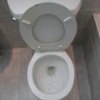 How To Repair a Toilet
How To Repair a Toilet
This is certainly a popular topic. Toilet leaks, toilet tanks and toilet flanges are all things that will need attention. The good news is that most items related to toilets can be dealt with in a fairly simple manner.
There are some things with a toilet that can have multiple issues. A toilet tank has more than one item in it th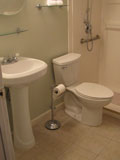 at could need attention. A 'running toilet' can be caused by one of two key components.
at could need attention. A 'running toilet' can be caused by one of two key components.
Have you been able to isolate your problem. There are several individual items, such as the 'toilet fill valve', 'toilet flapper', 'toilet flush valve' and 'leaking toilets' that you may want to focus on.
Are you facing the fateful, 'Toilet Clog'. You might develop of phobia about chewing your finger nails after this one (they say it is the first thing they teach plumbers). This home plumbing repair is not that terrible. However, you may want to consider wearing gloves.
Piping
Water supply lines, drains and gas lines all fall into this category. Pipes include valves and adaptors that connect them to the devices they are serving. Leaks and clogs are often the culprits behind piping problems.
'Troubleshooting' plumbing repair problems is all about figuring out what the problem is before you spend time and money trying to resolve. This segment has more specific descriptions and provides links to many more articles.
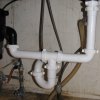 Drain Pipes
Drain Pipes
It is amazing how crippling it can be to your home when a drain is clogged. Boy, you never think about how nasty that water can be until it just sitting there staring at you. Is drain cleaning really a 'home plumbing repair'? Isn't it more like home repair torture.
What kind of clogs can you get? How about 'kitchen sinks' and 'bathtub drains' for a start. See what you need to do by following these links.
Some drains can be a big problem. However, most of the time it is not that difficult. Save the environment and stay away from the chemical drain cleaners. Learn a few tricks and you can deal with more than ninety percent of the drain clogs you will ever face.
Got some issues with the plumbing on your drains. See 'sink drain plumbing' for the low down drains below the sinks. Bathtub drain repair has the goods on these hard to get to drains.
 Sinks
Sinks
Kitchens, bathrooms, laundry rooms and entertainment areas all have sinks. Faucets and drains are integral parts and also the cause of problems.
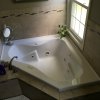 Bathtubs & Showers
Bathtubs & Showers
Keeping the family clean these devices have sophisticated water supply valves and a drainage system. They are not as problem prone as other devices, but the do act up.
Plumbing Repair Summary
At the top of each page we give you some quick evaluations of whether making a particular repair is really using common sense. In the end it needs to be your decision. After reviewing the information you feel comfortable making your own plumbing repair, go for it. Sometime you may need to buy a tool and some parts. Weigh those costs against the cost of a repairman. With a little determination you can save money and feel satisfied when you make your own home plumbing repair.
Home plumbing repair does require some specialized tools, depending on the scope of work. However, the majority of repairs can be made with a few simple tools that most households already possess. A screwdriver (one that accepts multiple tips) and a pair of adjustable pliers will make most of the repairs you will come across. See the tool suggestions for the basic tools to have handy, for your home plumbing repairs.
Can you make your own home plumbing repair? In most situations, the answer is Yes! Make sure you are familiar with the steps involved. Obtain the materials and tools required before you start. Follow the steps and take your time and you will be successful. Do something you want to with the money you save.
Home Electrical Repair
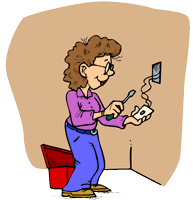 A home electrical repair that you do yourself can save you time and money. Often a first reaction is to be fearful of anything involveing electricity. This is a healthy reaction. A respect for electricity is important for anyone that works with or around electrical fixtures
A home electrical repair that you do yourself can save you time and money. Often a first reaction is to be fearful of anything involveing electricity. This is a healthy reaction. A respect for electricity is important for anyone that works with or around electrical fixtures
See the article 'Residential Electrical Safety Tips' for practical suggestions on working with electricity in a safe manner.
Many repairs only take a few minutes to perform and can save hundreds of dollars. Take the time to learn how to fix basic electrical items yourself.
We have become so dependent on electricity that we become agitated when it is off for even a few minutes in a storm. In the past century, modern man has learned to rely heavily on electricity.
There is a tendency to take electricity for granted. It is not until something does not work that we realize how much we miss it, when we don't have it. Move forward in your quest to make a home electrical repair and you won't be disappointed.
The Hoover Dam was once the largest dam in the world. It generates enough power to take care of 2,000,000 homes. That a lot of electricity from water that was just running down hill.
Home Electrical Repair - Finding Help
Below you will find some common problems you are likely to have with your electrical problems. There is a brief description and a link that will lead you to additional electrical information. Our evaluation sections of the pages will help you to decide if you want to make the repair. The "What Can You Save?" and "How Hard Could It Be?" sections give you a quick overview of the repair. This will help you decide if you feel confident enough the make your own electrical repair.
The "Check the Simple Things First" section will clue you in to easy fixes to check for. Is it possible to solve your problem without a lot of effort? Many times it is. In an effort to warn you about what you are in for, there is the "What Can Go Wrong" section. Benefit from the mistakes made by others, avoid problems.
Finding Information for a Home Electrical Repair
Below you will find various topics that are related to electrical repair. Try to find the one that best fits your situation and follow that link. You can always come back to this page if you guessed wrong.
Ceiling Fans
Ceiling fans are a different kind of light. Most of them have a light fixture attached to them. Ceiling fans are used to move air in your home. They have some special issues and need different kinds of home electrical repairs.
The link above will take you to an article that will help you figure out your problem. Are you sure that you ceiling fan is a goner? Or do you just want a new one? The old one is too noisy. The article 'Wiring a Ceiling Fan' will give you some good information on installing a new fan.
Doorbell Repair
Ever had someone standing outside your door pushing the doorbell and you had no idea they were there? Doorbells are another electrical device that can cause problems. You could get a piece of cardboard and make a sign "Doorbell Broken Please Knock" and tape it to the door.
Check out the link above for a discussion on all types of doorbells. Are you sure that you have a wired doorbell unit. Go to 'Doorbell Wiring', for a specific discussion on wired doorbell units. See the pages on 'Wireless Doorbells' for information on battery powered units.
Maybe your friends and relatives won't mind knocking. Even the UPS man might get used to it. On the other hand think how proud you will be if you are able to repair the doorbell. This home electrical repair is not that tough.
Electrical Wiring
This section includes all types of wiring in your home. Lights, switches, outlets and appliances all have some type of wiring. Some devices like ranges and electric water heaters use a lot of power. Phones and thermostats use very little. No matter what kind of wiring you have there can be problems. Electrical wiring is not generally for the novice. However, you do not need an electrical engineering degree to make some repairs.
Some of the topics discussed are 'repairing and replacing electrical outlets', 'replacing light switches', 'wiring three way switches', 'installing dimmer switches', 'repairing and installing light fixtures' and 'telephone wiring'. Follow these links to get more information.
Before attempting any electrical repair you want to take safety precautions. Pay close attention to the warnings and make sure that the power is off before you mess around with anything. With the right information and precautions you may find that you are able to fix some things yourself and save the cost of a repairman.
Basic Residential Wiring
Basic residential house wiring is a section that lists all of the elements that are found in most homes. It has descriptions and links to various resources that you will need to repair the various items.
Some of the topics discussed include: The 'main service panel', 'types of electrical circuits', 'types of electrical wiring', 'circuit breaker types', 'adding circuits to a home', 'replacing circuit breakers', 'how to wiring information', 'installing electric fixtures' and 'troubleshooting electrical circuits'. Follow these links to find out more information.
Home Electrical Repair Using Common Sense
Changing a service panel or even adding a new circuit in your home may be beyond your capabilities. Checking, repairing and replacing outlets and switches is certainly within the reach of most people. Installing a new light fixture or dealing with a ceiling fan is also possible. Use good judgment when evaluating the level of difficulty for any home electrical repair that you attempt. If you do that and are patient you will be successful.
You need to have a healthy respect for electricity when you make your home electrical repairs. Never work on any electrical item with the power on. Tag or tape the switches and breakers so that others will know you are working on the power. Use a tester to double check them before touching them. Make sure you know how to properly hook things up before turning the power on. Check out the page on 'Electrical Safety at Home' for more safety information.
Most things can be done with the normal tools you have, such as screwdrivers and pliers. A power tester and a pair of wire stripper/cutters come in handy. A battery drill and a reciprocating saw may be needed for adding or modifying circuits. There are other more specialized tools that are usually not needed by the average homeowner. Home electrical repairs should not overly tax your tool budget.
We hope you have found the information that you need to address your home electrical repair. Below you will find links to all the articles that we have available on home electrical repair topics. Check the 'Evaluation Section' and give the 'Steps' involved a quick look. If it sounds practical for you, read the information carefully and follow the steps. Keep the hair dryers running and your family will thank you.
A History of the Toilet
A Complete History of the Toilet
There is some misinformation about the history of the toilet. Did Thomas Crapper really invent the modern day toilet? Was the toilet first invented in the sixteenth century? Who was the first person to use a flush toilet? These and other burning questions about the modern day toilet are answered in this article.
In recent history the toilet has been a center of attention when it comes to water conservation. A few decades ago, toilets used 7 gallons of water per flush. Now there are toilets available that use as little as .8 gallons per flush.
In developed countries, most homes have toilets. The history of the toilet in the last few centuries has led us to this end. Most people shudder at the thought of using an out house. It was not that long ago that this was a common practice.
Thomas Crapper's Role in the History of the Toilet
With a name like that, most people would jump to the conclusion that he must have been involved in inventing the toilet. The next conclusion would be that the slang word 'crap' (referring to human waste) had to originate with him.
Sorry, wrong on both conclusions. Thomas Crapper did hold patents on some toilet parts. The ball cock being the most notable. He was even guilty of borderline false advertising in the nineteenth century when his adds implied that he had invented the siphonic toilet.
What he did do was manufacture and promote the toilet as a sanitary device. Urban legend has credited him with the invention of the modern toilet erroneously. I am also sure his descendants are glad that 'crap', coming originally from the French word crappe, did not originate with him either.
Who Did Invent the Toilet?
Most would tell you that John Harrington invented it in 1596 to win favor with Queen Elizabeth. However the idea did not catch on and it was not until the end of the eighteenth century, that a patent was taken out. In 1775 Alexander Cummings invented the S Trap that is still used in modern toilets. In 1778 Joseph Bramah invented a toilet that is very similar in functionality to the ones we use today.
Thomas Twyford invented the first one piece china toilet using the s trap siphon design. Since that time there have been incremental improvements. In 1861 Thomas Crapper started producing toilets and made minor improvements on designs that were already in existence. In the late 1800's the use of flush toilets became more common in Europe and the United States.
Modern Development in the History of the Toilet
In the early twentieth century the tanks were lowered and put right on top of the bowl, similar to the ones we use today. Prior to that, tanks were mounted high on the wall to take advantage of gravity to generate pressure. Now you can pay extra and get a retro toilet with a high tank. Go figure.
From the 1960's until now it has been all about water usage. Toilets have gone from using as much as seven gallons per flush to using as little as .8 gallons with the newer pressure assisted models. This has not been without problems. Reducing the amount of water without improved engineering has resulted in toilets that have to be flushed more than once or that are prone to clogging.
In 1992 the federal government in the United States stepped in and mandated that toilets use no more than 1.6 gallons per flush. At first all the manufacturers did was lower the amount of water in the toilets via various methods. Toilets made this way clogged regularly and often required multiple flushes. Bowls and siphoning configurations were changed and the flushing improved.
Now we have some very good toilets that flush properly with 1.6 gallons using just gravity. Some pressure assist models can flush liquids and leave the bowl clean with only .8 gallons of water. This is considered to be a green initiative and lowers water costs for homeowners.
Using the First Toilet - Who Was It?
Was Queen Elizabeth privileged with the first use of a flush toilet? Well, actually, no. Archaeologists have found evidence of flushing toilets as far back as 2,500 B.C.E. Flush toilets were used in both China and India in ancient times. The Romans also had flush toilets.
For an unknown reason the use of flush toilets was lost with the fall of the Roman Empire. So to most the invention of a toilet in 1596 would certainly seem like something new.
History of the Toilet Summary
The history of the toilet is not something you would take night classes to learn about. It is a common item in practically every home in many countries. Knowing a few facts about the toilet is not a bad thing. Being able to refute a common misconception about who actually invented the toilet could be useful at some point.
Hot Water Heater Sizes
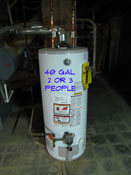 We often blame the poor hot water heater thermostat when we don't have enough hot water. Is it really the fault of the thermostat? How many people do you have in the have in the house? Do you have teenagers? It could be that your hot water tank is smaller than you need.
We often blame the poor hot water heater thermostat when we don't have enough hot water. Is it really the fault of the thermostat? How many people do you have in the have in the house? Do you have teenagers? It could be that your hot water tank is smaller than you need.
Do you have five or more people in the house? Would you consider your demand high? You should probably have a 75 gallon hot water tank. 50 gallons minimum.
I had a 60 gallon gas hot water tank when my children were at home. We got by, but often we did not have enough hot water (six people in the house). After all but one of the children moved out, I had to replace the tank. Forty gallons, no problem, right? Well, I put in a whirlpool for my wife and she still complains that there is not enough hot water.
Water Heater Recovery Rate
The size of the water heater is one thing. If no one has used the hot water for a while, you have a full tank of hot water at your disposal. What happens when the hot water starts to get used. In the morning when everyone in the house takes a shower. When you are washing clothes or running the dishwasher. Then the water heater needs to 'recover' or heat more water.
The recovery rate is as important if not more important than the size of the water heater. If everyone gets ready for the days activity in the morning and you have an hour and a half or two hour window of time. The question would be, how many showers can the water heater handle.
Understanding Recovery Rate
When you don't have enough hot water, understanding the recovery rate of your water heater, may help to keep things in perspective. Water heaters can only heat water at a certain rate. Gas water heaters are faster than electric ones.
The things that needs to be understood is that stated recovery rates are calculated on 'temperature differential'. Boy that's a mouthful, what does that mean. Well it sounds more complicated than it really is. Let's say you live in the Northern part of the United States, the water is going to be colder coming out of the pipes than if you lived in the Southern part of the country. So the stated recovery rate may vary somewhat.
Continuous Use
It may seem like simple math. You have a fifty gallon gas hot water heater with a 40 gallon per hour recovery rate. You have a combination of five adults and teenagers that need to take showers. At an average of 8 gallons of hot water per shower you should be good, right?
The reality is that if all five showers are taken in the space of an hour, the last two or three may not have the desired level of hot water. After the first shower, eight gallons of cold water have been introduced into the tank. The water heater starts working, but now the second shower has started and more cold water is brought in and so on and so on. Depending on the length of the showers and other factors, you may come to the conclusion that getting up early is the best way to insure a hot shower.
Electric Water Heaters
If you have an electric water heater and have significant hot water demands you could be looking at a tank that is 80 or 120 gallons in size. This is mostly due to the slower recovery rate for electric water heater.
Gas Water Heaters
Water Heater Sizes
The size of you water heater is important. The traditionaal concept of 'more is better' is somewhat true. Obviously, a bigger water heater will have more hot water. However, hot water needs play into the equation. For a small household, say one or two people, why would you want to keep sixty gallons of hot water when you probably could do with thirty? Remember, you have to pay to keep that water hot. If you heat it and don't use it, you are wasting money.
So the question is, what is the proper water heater size for your house?
Summary
Bottom line, hot water tanks need to be sized by needs. Making the water so hot that it will scald you if someone turns a faucet on is not a good solution. You may need to think about a larger hot water tank.
Replacing your hot water tank is a big job. Not impossible, juts some work. Do you think you are up for the challenge? Take a look at the article 'Gas Hot Water Heater Installation', before you decide. It is a job you may be able to do. You could save several hundred dollars.
Hot Water Heater Temperature Settings
 Adjusting hot water heater temperature settings is something you can do for both gas and electric water heaters. The critical question is, 'How Wise Is It?', the factory settings are at a safe level.
Adjusting hot water heater temperature settings is something you can do for both gas and electric water heaters. The critical question is, 'How Wise Is It?', the factory settings are at a safe level.
The main reason that you would consider this is to get more hot water. It is possible that you need more hot water or you may have a malfunctioning hot water heater that is not yielding as much hot water as it should. In both situations, raising the water temperature is a poor idea. If something needs to be fixed on the hot water heater it would be wiser to fix it.
See the articles 'Troubleshooting Gas Hot Water Heater Problems' and 'Electric Hot Water Heater Troubleshooting' for a list of issues related to too little hot water. Both of these articles have several questions that are related to hot water quantity problems. Not sure what type your water heater is? Some tips on how to identify your particular type of water heater are found in the articles 'How To Shut Down a Gas Water Heater' and 'Shutting Down an Electric Water Heater'.
Hot Water Can Be Dangerous
So how dangerous is hot water? At 160 degrees water can cause a second or third degree burn in a half of a second. Do you have children, elderly, infirm or handicapped individuals in your home? Caution needs to be exercised.
The 'Accurate Building Inspectors' website has a page with a great visual graph that shows how dramatically the chances of burns are increased when the water temperature is increased. Water that is too hot can cause serious injury even death. This website has statistics that shot that more than thirty people die and nearly four thousand people are injured each year from hot water related burns.
Most water heaters are set at the factory for 120 degree hot water. Even at this setting, the water can feel pretty hot when there is no cold water mixed in.
Who Uses Straight Hot Water?
This is a valid argument. You always mix hot water with cold water for most things like showers, the dishes, etc.... So, as long as you are paying attention, you can adjust the temperature by using cold water. Seems like a perfect solution. However, as noted above, it is possible to make a mistake and turn the water on full hot accidentally and this could result in serious injury.
I have the water heater set to the factory settings in my home. At our kitchen sink we have a single lever faucet that is fairly touchy. I have to say even at normal factor settings the water is often too hot to leave your hand there for more than a second or so. At a hotter temperature, I am sure I would have been burned more than once.
Need More Hot Water?
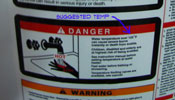 You may be thinking that raising the temperature is and easy way to get more hot water. In theory it is, but there are consequences. Have you made sure that your hot water heater is working properly? See the article Gas Hot Water Heater Troubleshooting for tips on what to do if you don't have enough hot water.
You may be thinking that raising the temperature is and easy way to get more hot water. In theory it is, but there are consequences. Have you made sure that your hot water heater is working properly? See the article Gas Hot Water Heater Troubleshooting for tips on what to do if you don't have enough hot water.
It is also possible that you are asking more of your water heater than is reasonable. See 'Gas Water Heater Tank Size' for information on the proper sizing of a hot water tank. Don't blame your gas water heater thermostat if you tank is too small.
Actually changing the setting is simple. You will find a dial on the front of your gas valve. Turn it toward 'Hotter' or the higher temperature to increase the temperature. Check you owner's manual for the recommended setting. It is most likely 120 degrees. There is usually a mark on the dial for the suggested setting. The danger factor goes up exponentially for each ten degree increase.
WARNING!! Hot Water Can Cause Severe Burns! Be Careful! 120 Degrees is the Suggested Setting!!! WARNING!!!
Changing Water Heater Temperature Settings
Of course it is possible to change the water heater settings on your hot water heater. If you think the setting is too high, you may need to lower it. So if you need to change the settings it is not that difficult. If you intend to raise the temperature, do so with caution.
Gas Hot Water Heater Temperature Adjustment
On a gas hot water heater the temperature dial is on the gas valve at the bottom of the water heater. All you have to do is turn it to make an adjustment.
Most heater have a hatch at the factory setting and they may say something like 'Warm' and 'Hot' to give you the sense of which way to go. It is best not to deviate too far from that mark. If the temperature had been set higher by someone else, lower it back to the factory setting.
If you are raising it, BE CAREFUL.
Adjusting Electric Water Heater Temperatures
On an electric hot water heater, changing the temperature is more difficult. Most electric hot water heaters have two thermostats, on the thermostats there is a temperature setting dial. Similar to the gas water heater there is a mark for the factory setting.
The bad news is that the the thermostats are not exposed. They are behind access panels. To safely access them, you should shut the power off for the water heater. See the article 'Shutting Down an Electric Water Heater', for instructions on safely shutting off the power.
With the power shut off you need to remove the access panels. Your water heater has two thermostats, therefore, two temperature dials. The panels are located on the side of the hot water heater. One will be in the lower third of the unit and the other will be close to the upper third.
There may be a layer of insulation that conceals the thermostat from view. Carefully move the insulation aside. The temperature adjustment will be toward the bottom of the thermostat. It may say something like 'Hot' and 'Very Hot', or it may have the degrees listed. 'Hot' will normally be the factory setting or the degrees should be around 120.
Try and stay as close to the factory setting as you can. See above for the dangers of setting it too high.
Where To Next?
Need More Hot Water Heater?
There are things that could be wrong with your hot water heater that will cause the amount of hot water to be reduced. For a general discussion on issues with hot water see the articles 'How To Troubleshoot a Gas Hot Water Heater' and 'Troubleshooting Electric Water Heater Problems'. Several of the topics covered discuss a lack of hot water.
Do you have an electric hot water heater? Most electric hot water heaters have two heating elements. If one of them fails, you will still have hot water but a lot less than you should. See the article 'Checking Hot Water Heater Elements' for instructions on how to test them.
Another factor that can reduce the amount of hot water is a sediment build up in the bottom of the tank. This is especially true of older hot water heaters. See the article 'How To Remove Water Heater Sediment' for more information.
Another less likely problem could be your dip tube. Sure we understand, you probably didn't realize that you had a dip tube, let alone that it could be a problem. It is a feature in a hot water heater that directs the cold water into the bottom of the tank. Over time this tube can disintergrate, causing the cold water to cold water to be introduced into the top of the tank. Yes it will sink in time, but until it does the thermostats will not realize the need to heat the water. This inefficiency reduces the amount of available hot water. See the article 'How To Replace a Dip Tube' for more information.
Replacing a Hot Water Heater
There are many reasons why you might need to consider replacing your hot water heater. One big one, would be changes in need. When the size of a household increases this may put strain on a hot water heater. If the water heater is too small for the size of the household, there will be problems.
Replacing a hot water heater is a big job. Even if you hire it out, there will be an investment of time and a considerable amount of money getting it done. You can save quite a bit of money if you do it yourself. However, this is a big job and and not appropriate for novice diy enthusiasts. If you are comfortable with your plumbing skills and have some help, you may be able to tackle it


